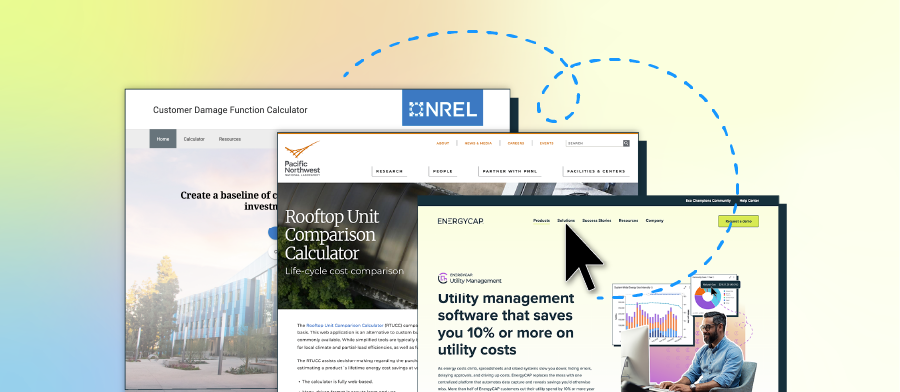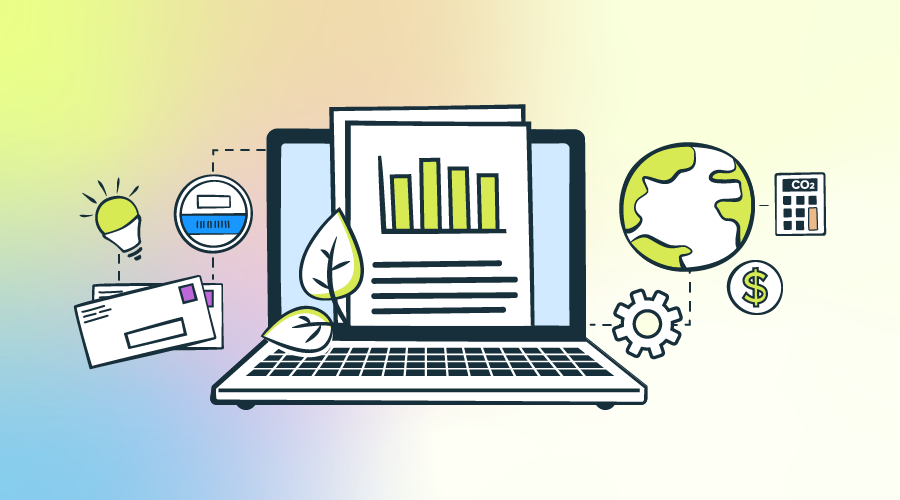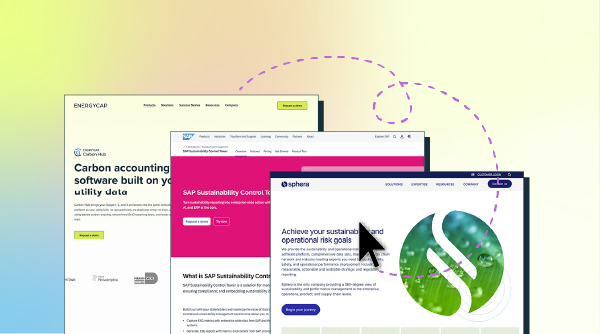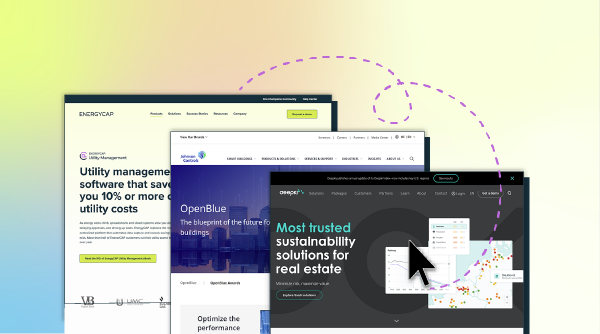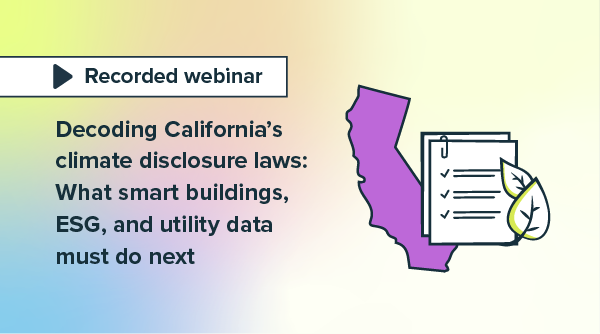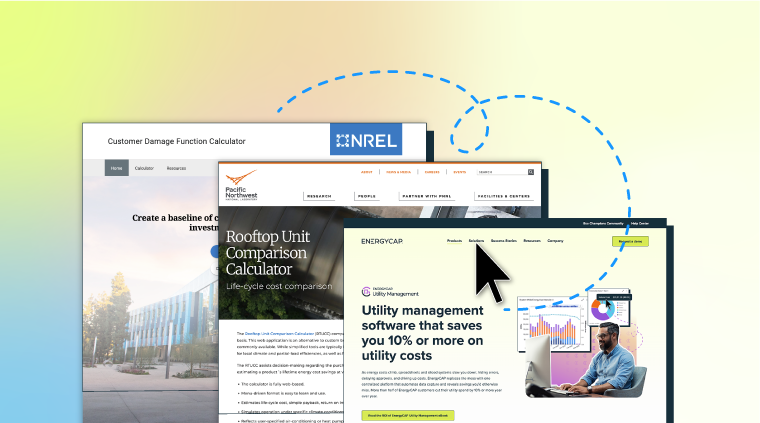Increasing greenhouse gases and overall concerns about the climate have led to a global push for more advanced Energy and Sustainability Reporting.
If you’re just getting started with sustainability, you may be wondering: When it comes to greenhouse gases (GHGs), are all factors equal? A wide variety of factors contribute to GHG emissions, such as capital goods, purchased goods and services, transportation, waste, water, energy, and more.
As it turns out, 40% of global greenhouse gas emissions come from buildings, and if we continue to operate business as usual, they’re set to double by 2050. So, focusing on building emissions is one of the best ways to reduce greenhouse gas emissions. The good news, utility data from buildings is ubiquitous and relatively easy to measure, making it the ideal starting place for sustainability reporting.
However, you can’t manage what you don’t measure. Many businesses simply do not efficiently and accurately track building energy usage, which makes it much more difficult to reduce greenhouse gas emissions.
If you want to take control of your data, the fastest way to do so is to employ energy reporting best practices. This blog reviews these best practices and helps you gain a better understanding of where your organization needs to improve.
The 4 Pillars of Energy and Sustainability Reporting
There’s a lot more to energy and sustainability reporting than you may realize. It’s not a switch you can flip on or off, but rather a continuum you can travel along to meet your performance goals. Energy reporting is broken down into four distinct steps:
- Capture: Follow best practices to ensure you’re efficiently and accurately capturing and organizing your utility data.
- Visualize: Leverage configurable reporting tools and dashboards to visualize your data and document your progress over time.
- Share: Get decision-makers involved by sharing your utility data and any progress you’ve made.
- Analyze: Put your data to work by integrating and analyzing with business intelligence tools and other systems.
Capturing energy usage data is essential, but it shouldn’t be filed away to collect dust. Taking this data and visualizing it makes it much easier to identify trends, errors, and other actionable insights. Sharing these insights with decision-makers helps get the ball rolling. Finally, analyzing the data over time ensures sustainability can be achieved.
Capturing and Organizing Data
Since you can’t manage what you don’t measure, capturing and organizing your energy usage data is the most important part of the process. However, the way organizations capture this data matters quite a bit; some methods are much more efficient and accurate than others.
There are four levels to the data capture continuum:
- Accounting Data Only: Utility bills are received and paid by the accounting department. Only energy cost information is captured; no energy data is captured.
- Basic Energy Management: The energy team gleans energy usage data from utility bills. This energy data is stored in Excel or another type of non-enterprise software. Additionally, the energy data is often owned by an individual and can be lost when they transition out of the organization.
- Energy Management: Captured energy data is stored in home-grown or other enterprise facilities software, which allows for ad-hoc reporting on both energy cost and usage. While this is a clear step above the previous two stages, it’s still a square peg in a round hole.
- Energy & Sustainability ERP: Leverages a streamlined process that automatically captures both energy cost and usage data. This data is stored in an enterprise solution that allows for easy access and reporting. There’s little to no manual data entry, and the data is accurately allocated to appropriate end-users with efficient workflows.
Where does your organization fall on the data capture continuum? We polled attendees during a recent webinar on energy reporting best practices, and these were the results:
These poll results are encouraging because it shows that the average organization is on the mature end of the data capture continuum. However, 68% of those polled rated their organizations lower than “Energy & Sustainability ERP,” meaning there’s also a lot of room for growth in the effort to reduce greenhouse gas emissions.
Capturing data consistently and accurately is essential to energy reporting as well as any sustainability initiatives. Manual processes, such as manually copying utility bill data into spreadsheets, lead to inconsistent and inaccurate data. When organizations cannot trust their data, they cannot optimize their energy usage.
Additionally, manually recording energy usage data requires a lot of time and money that businesses often do not have. Automating the data capture process is significantly more efficient, allowing energy managers to spend their time more wisely.
Visualizing and Documenting Your Progress
Capturing energy usage data is a great start, but data on its own is often difficult to digest. Visualizing this data is the best way to identify trends, errors, and other useful nuggets of information.
There are four levels to the data visualization continuum:
- No Visualizations: Any form of data visualization is manually produced for regulatory or budgetary purposes.
- Custom Spreadsheets: Visualization is handled through custom spreadsheets, which can be limiting. For example, the visualized information contained within these spreadsheets is not flexible to be used for any alternative purposes.
- Energy Reports: Companies in this stage can generate reports for a variety of purposes, but developing new reports typically requires significant effort. Any infrastructure changes, such as new buildings being added or existing buildings being demolished, require the reports to be recreated. Additionally, they have limited or no dashboards.
- Energy & Sustainability ERP: Standard reports are readily available while custom reports can be created quickly. Dashboards and other visualizations are easy to create and manage. Adjustments are simple, even in the case of infrastructure changes.
Where does your organization fall on the data visualization continuum? We polled attendees during a recent webinar on energy reporting best practices, and these were the results:
Once again, these results are encouraging to see. Still, the ultimate goal is for these visualizations to be effortless to produce, and the vast majority of those polled indicated they were relying on methods that are burdensome.
Much like with the data capture process, manually creating reports, visuals, and dashboards can be very time-consuming. Even worse, reports that are created manually need to be recreated when new data is available. Organizations interested in energy reporting best practices should look to find software that can create visualizations and dashboards automatically.
Data Sharing
Data sharing is an easily overlooked aspect of energy reporting best practices. However, for any sustainability strategy to succeed, it’s essential that energy usage data is communicated to stakeholders and other decision-makers.
There are four levels to the data sharing continuum:
- No Sharing: Energy data is siloed in energy management or accounting departments.
- Shared as Needed: Energy data is manually compiled and shared with organization stakeholders via email or print.
- Reporting Servers: Stakeholders outside of the energy team have access to some energy data reporting. Reports are designed to be “pulled” by the stakeholders, and they have a limited ability to configure said reports.
- Energy & Sustainability ERP: Dashboards and visualizations can be shared at the click of a button, and reports can even be automatically pushed to stakeholders. Additionally, stakeholders can self-configure reports to fit their needs. Dashboards are public and contain real-time information.
Where does your organization fall on the data sharing continuum? We polled attendees during a recent webinar on energy reporting best practices, and these were the results:
The poll results here show a noticeable shift toward the lower end of the continuum, with 59.5% of organizations occupying that space. Organizations must strive to be consistent with energy reporting; being adept at data capture and visualization isn’t enough.
Collecting and visualizing energy usage data is great but failing to share it makes all the effort pointless and does nothing to help reduce an organization’s greenhouse gas emissions. Stakeholders and decision-makers need to be aware of energy usage data in order for the proper actions to be taken.
For data sharing to be effective, it should also be a very simple process. The more steps it takes to share something, the less effective it will be. If possible, sharing dashboards and other visuals should be as easy as clicking a button. Even better would be automated reports that are periodically sent to stakeholders.
Analyzing and Improving
The ultimate goal of an energy and sustainability strategy is to reduce energy consumption, emissions, and cost which is why this final step in energy usage reporting is so important. Capturing, visualizing, and sharing the data is only effective if the organization analyzes the data to make improvements.
There are four levels to the data analysis continuum:
- No Analysis: Energy data is never reviewed, except during crises, and utility bills are paid as received.
- Ad-Hoc Analysis: Energy cost and usage data is reviewed on an ad-hoc basis. These reviews are typically driven by a motivated energy manager or accountant.
- Robust Analysis: Workflows exist to review energy cost and usage data. Various software, some of which may be custom-made for the organization, are used for this purpose. Error detection can be inconsistent.
- Energy & Sustainability ERP: Documented and automated workflows identify outliers, and energy data is always utilized for business intelligence. Staffing changes do not impact these processes.
Where does your organization fall on the data analysis continuum? We polled attendees during a recent webinar on energy reporting best practices, and these were the results:
Similar to data sharing, this poll indicates that there’s some work to be done when it comes to data analysis. While it’s clear that many organizations do have processes in place for energy and sustainability reporting, most have some work to do when it comes to implementing best practices.
Analyzing your organization’s energy usage can elevate reduction opportunities. Failing to do any analysis, or only reviewing the data when it’s absolutely necessary, will not move the needle for a company’s energy usage. Any organization that wants to employ energy reporting best practices should invest in software to help identify areas for improvement.
Empowering Your Data with EnergyCAP
Continuing to rely on spreadsheets, manual processes, subpar reporting, and other inefficiencies won’t help you meet energy reduction mandates, save money, or achieve net-zero emissions. If you’re an energy or sustainability leader that wants to take control of your data and employ energy reporting best practices, EnergyCAP’s energy management and utility bill accounting software is the perfect solution.
EnergyCAP is the only Energy & Sustainability ERP that empowers Energy & Sustainability leaders with full control and understanding of all energy data points to manage consumption, reduce their carbon footprint, and drive savings.
With EnergyCAP, your organization can:
- Streamline Data Capture: Our software saves you time by streamlining your utility bill accounting workflow by automating repetitive accounting and energy management tasks. We can also handle all of your utility bill processing and management with our Bill CAPture service.
- Get Reports and Dashboards: EnergyCAP’s reports and dashboards make it easy to analyze energy data for any time period or organization level. You can customize, share, and even embed these reports with just a few clicks.
- Identify Energy Issues: Our software will automatically flag abnormal energy use, costs, or demands, making it simple to audit and approve bills before they are paid.
If your organization is determined to reduce greenhouse gas emissions, EnergyCAP is the perfect sustainability partner. Request a live demo to see why over 10,000 energy managers trust our software.



![Top 12 sustainability reporting platforms (ESG) [2026]](https://www.energycap.com/wp-content/uploads/2025/12/blog_article_top-sustainability-platforms.webp)

